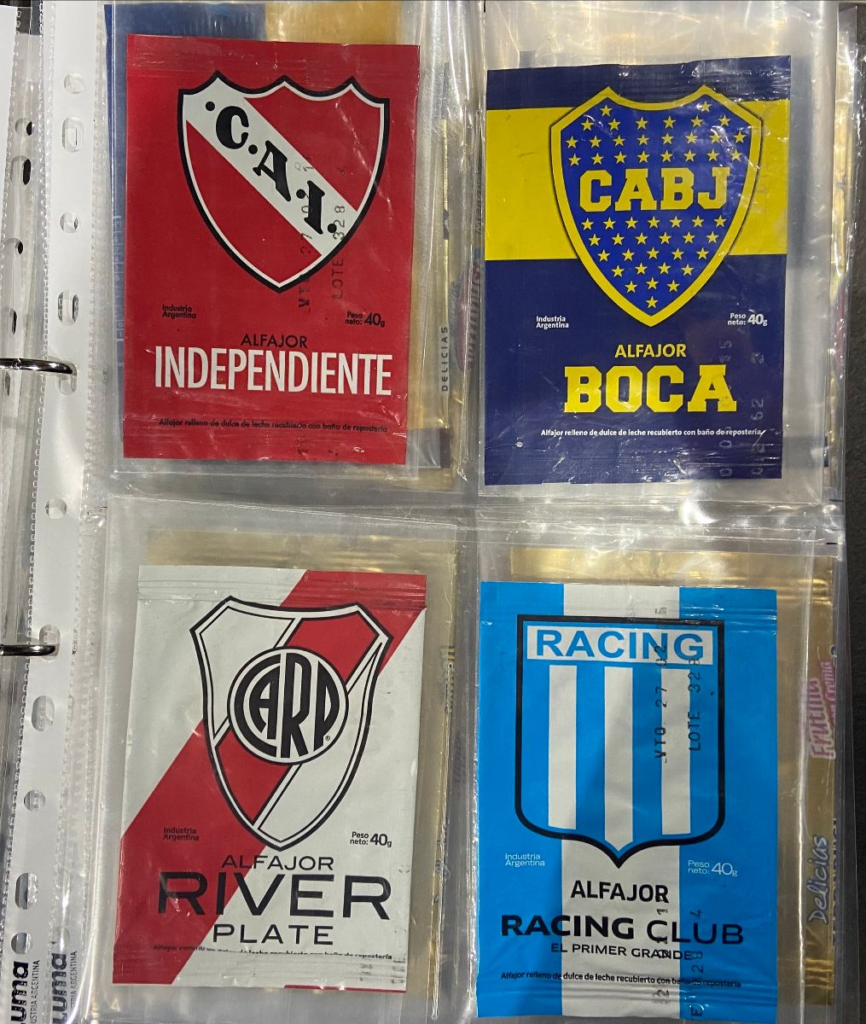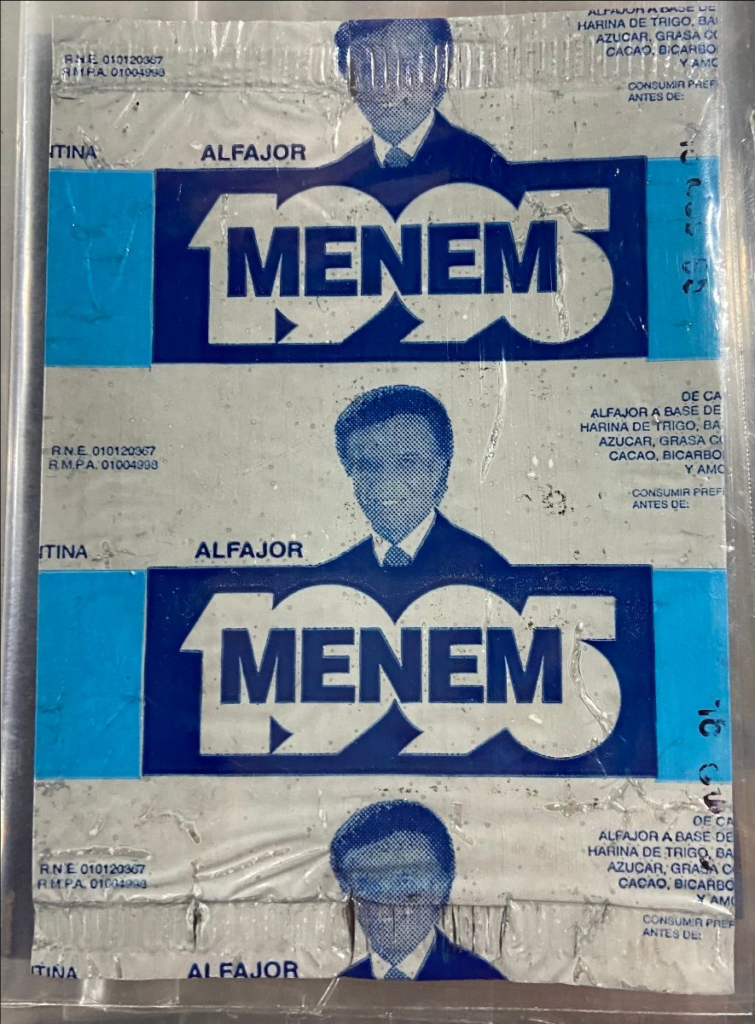As I stepped into the bustling warehouse of desserts, I was confronted by a man in a full-body cow suit standing over a heap of loose cinnamon buns… around the corner, a chocolate scientist live-streamed industry secrets… wait, are those free samples? That’s right, welcome back to La Rural.
Last month, I wrote about Exposición Rural, a celebration of rural Argentinian food, sport, industry, and tradition hosted at the La Rural fairground (if you missed it, you can read it on my new website—thanks, Dad!). While the exposition is one of La Rural’s most popular events, it’s far from the only one. The fairground hosts a huge array of multi-day markets, conferences, and cultural expositions throughout the year, tallying 163 events in 2022. This weekend’s event was a convention, competition, and above all celebration of the Argentinian alfajor, pictured below.

An alfajor is an ungodly dallop of dulce de leche between two butter cookies. Pictured is a Buenos Aires classic, but variations and reinterpretations abound.

The 2023 World Champion alfajor—with, of course, appropriate homage to Messi.
Though the Campeonato Mundial de Alfajores got just one tenth the daily visitors of Exposición Rural, you wouldn’t know it from the elbow room. The Campeonato was confined to an indoor segment of the fairground, with the low roof and narrow aisles amplifying the chaos of a thousand Argentinians unleashed in an alfajor faire. Like moths to a flame, I thought, though I too had flown eagerly to the light. The fair was a hive of stands, some boasting rare and bizarre flavors, like rum or jalapeño. Others promised deliciousness with scientific certainty, such as the chef lecturing on the ideal darkness and melting point for chocolate coatings.

Chocolate chalculations
Although alfajores are not exclusively Argentinian, they carry an exceptional cultural force here. Mass-produced versions flood kioskos, the ubiquitous 24-hour snack stores, and any café in the city is likely to have their in-house variety. The dessert is a symbol of national identity, though other loyalties are also communicated on the wrappers.

Aflajor wrappers from Independiente, Club Atlético Boca Juniors, Racing, and River Plate, the most popular Argentinian fútbol teams. Fun fact: after one too many violent confrontations, away fans are no longer allowed at the home stadiums for games.
The above picture is from an alfajor wrapper collection, displayed in binders for passerby to flip through. The first thing that caught my attention was the huge range of communities and interests printed on the packets. The local fútbol team logos were amusing if not expected; perhaps stranger was the Ben-10 wrapper and early 2000’s “Alfajor Rebelde” (Rebel Alfajor), a flailing attempt at edginess to target the teen market. Most striking, however, was the collector’s oldest wrapper, a 1995 gem featuring ex-president Carlos Menem. Menem was president of Argentina from 1989-1999, and this alfajor was manufactured as part of his campaign. I struggle to think of a U.S. parallel, but we’re somewhere in the realm of Bill Clinton on a Wheaties box.

Alfajor à la Menem
As the Menem wrapper exemplifies, food is a cornerstone in the construction of nationhood and citizenship. National identity is not just imagined but enacted, and cuisine is a tangible, day-to-day way that people identify with a political community. Emiko Ohnuki-Teirney underscores this corporal relationship, where food acts as “a unique metaphor of the self of a social group… when each member of the social group consumes the food, it becomes a part of his or her body.” I buy the Menem alfajor in assent to certain ideas about what Argentina is and ought to be, and my own Argentinian-ness is communicated by eating the symbolic dessert. The Menem alfajor also shows us that, like all enactments of national identity, cuisine is perpetually contested.
One interesting case of food and national identity is falafel and hummus in Israel and Palestine. Brittany Power explores Israeli and Palestinian cookbooks and cooking shows to argue that both countries mobilize falafel and hummus to communicate attributes of their citizens. She cites one cooking host who says, “Hummus is from the bible, you might say it is food for the poor, you understand?… yes it is tasty, filling and cheap… chickpeas are of this land and so are we and of the nation of Israel too, and also our Jewishness.” This example highlights how the consumption of national foods is not only linked to pride, but the country and region’s history, as well as how the community imagines its ideal citizen. Note, too, that these attributes aren’t “pre-existing” in the food; rather, they result from its preparation, ingredients, and relation to the land. The dish, as a final product of these historical and preparatory processes, is woven with the identity that each nation ascribes it.
Menem’s alfajor also stakes a claim for national identity, but through very different mechanisms. In a departure from the falafel’s focus on production, authenticity, and historical legacy, Menem’s alfajor has everything to do with the aesthetics of packaging and delivery. We often think of distribution as a neutral process in the sense that it doesn’t actually alter the characteristics or qualities of the goods in transit. Yet the commodification of nationally symbolic foods like alfajores has opened a new space—the package—where claims to national identity are externalized from the food itself to “post-production” processes of transport and presentation, allowing enterprises, politicians, and social groups to mediate our relationship with food through portraits, symbols, and explicit ideological messaging.
Nowhere was this clearer than the alfajor wrapper collection, where, despite the absence of any actual alfajores, the ideology and identity constructed by each packet remained perfectly intact. Gone is what the customer supposedly paid for, left over is what Slavoj Zizek elegantly calls the commodity’s “something more.” While the cookie element of a Menem-fajor might as well have spawned from Jupiter, its presence is not irrelevant. The alfajor is a ritual enactment of Argentinian-ness, facilitating the identity-through-edibility link laid out by Ohnuki-Teirney. The thing to note about the physical dessert is that, while it serves as a crucial link to the material world, social groups’ identities are projected and elaborated on its wrapping, not via any tangible quality of the alfajor itself. The demands and capabilities of global production, serving markets across massive distances and times, have enabled this externalization of our social relationship to cuisine, which no longer concerns food itself but the thing that envelops it.
From TV shows to athletic clubs to politicians, it’s clear that the alfajor is more than a representation of national identity. It’s a vehicle for social groups and consumers to embroider their claim to Argentinian-ness, carving complex and niche identities through the consumption of nationally renowned deliciousness.
While going to a championship for dulce de leche cookies didn’t take much convincing, I find myself coming back to La Rural for more than great food. The fairground is a rotating door of opportunities for a deep dive into both oddly specific and historically foundational parts of Argentinian culture. Its massive square footage accommodates more interactive experiences and immersion than many cultural centers or galleries. Each event draws specialists and professionals—everyone who’s “in deep”—alongside mere casual enjoyers to share their love for an art, sport, music, or hobby.
Now, for a change of pace, please welcome the First Poem of Lucas’ Blog: The Ghost of Al Fajor.
Cloaked in darkness, a heart of gold
She’s apt to steal hearts, I’m told
Layered but simple, soft and pure
A delight for the mouth, of that I’m sure
Loved north to south, by rich and poor
In your hands lies the fable of Al Fajor
Al called to me one eve, so late
So I took my leave, with fork and plate
And chanced upon a corner store,
Rubbed my belly, and strode in the door
I open a packet, gentle and sure
Caramel softness spills from the core
Before too long, crumbs litter the floor
This will not do, I must have more!
So one, then two, then three and four,
I stuff my face like a pot-bellied boar
I hear the shouts as I rage and roar:
“He’s mad, he’s mad, for the alfajor!”
The brakes are off, shoppers rush for the door
They haven’t seen it this bad since back in ‘04
It’s chaos and crying, “he’s wretched, eh?”
But I can’t hear them over all this dulce de leche
Fires blaze, lightning cracks, the roof threatens collapse
One shelf to go, and it’s all under wraps
I raise reddened eyes to the final foe
And see it’s the legend Alfajor Oreo
I climb to my knees, hair on my skin rising
To face this Miracle of American Advertising
I unleash a belch, tummy swollen and sore
Then spinning, spinning, my head meets the floor
Lips coated in chocolate, a childish gore
I fall into slumber, and drool and snore
The clerk looks upon me and pities the sight
Collecting wrappers, he sighs, just another night.
And so our hero was forgotten, but I’ll tell you this:
The cookie sandwich monster slept in no bliss
He was taken by nightmares and witches and wights
And yearns for his Al, but gets no such delights
Yes he’s still around, though they’ll say it’s just lore
His ghost comes at night, knock knock at your door
To beg on his knees, he’ll do anything and more
If you please just spare him an alfajor!
Thanks for reading! Hope you enjoyed Lucas’ Blog: Alfajor Edition.
Until next time,
Lucas
P.S. I wanted to shoutout the wrapper collector, who is an absolute character and also named Lucas! Here’s his Instagram, YouTube, and a TikTok he’s featured in.
P.P.S. On my way out of the faire, I was stopped by a small crew for an interview, which I have uploaded for your enjoyment (and as a prize for making it to the end :D) You can watch the 59-second pelotudez here.